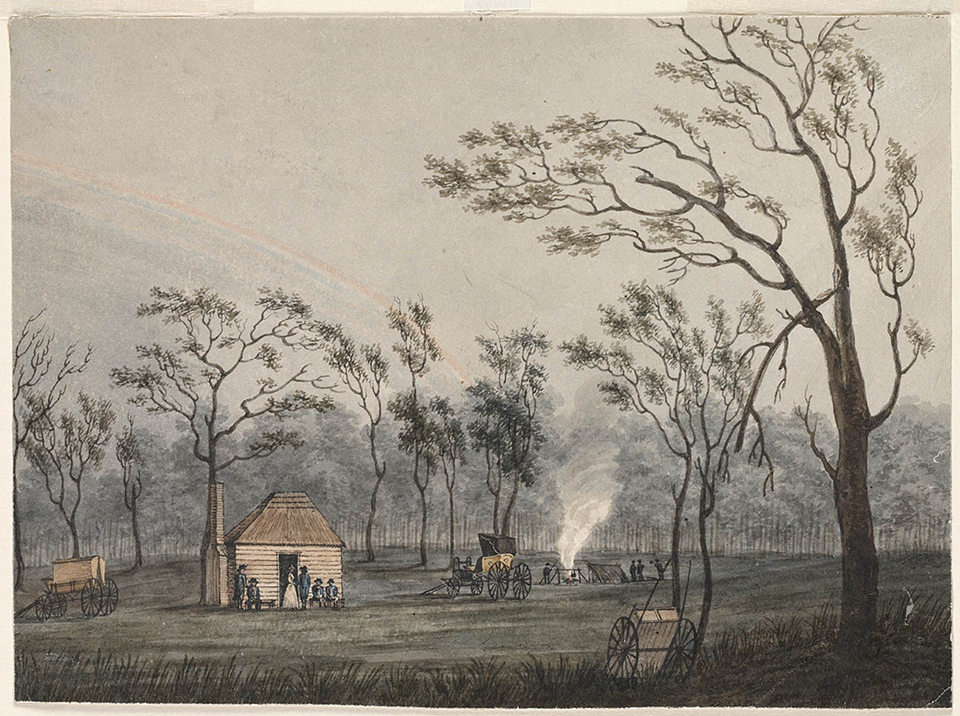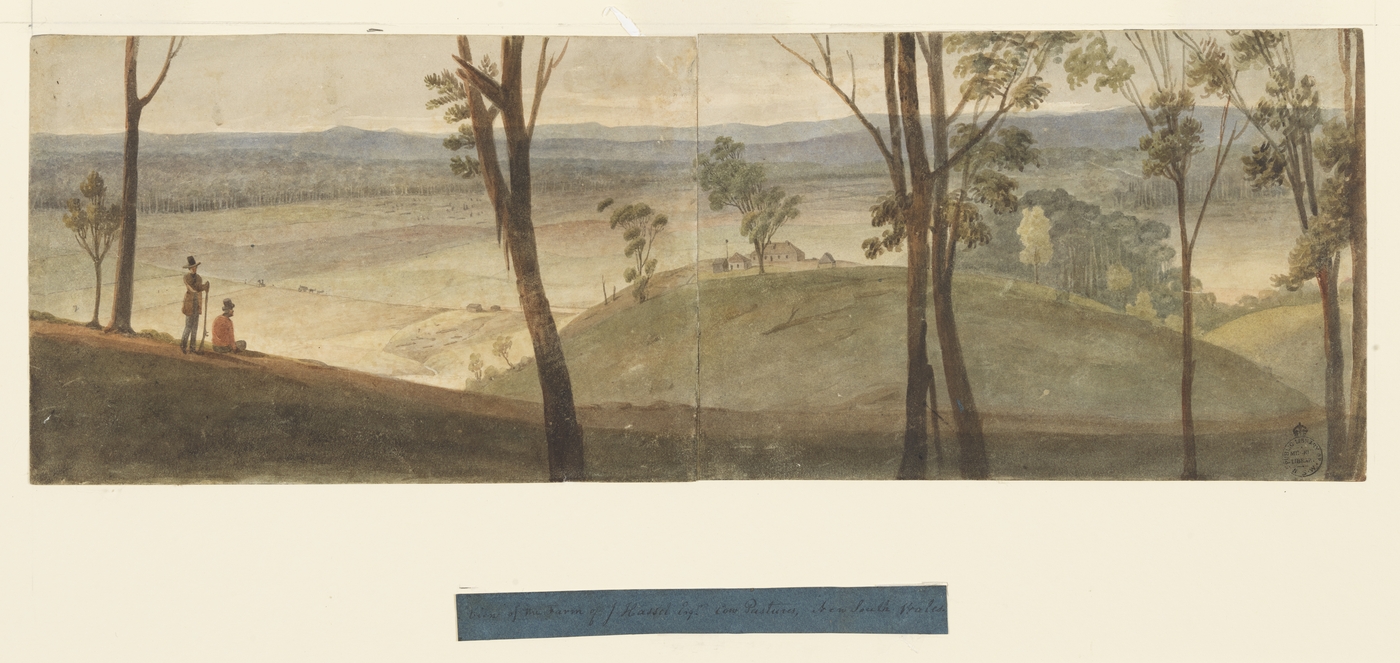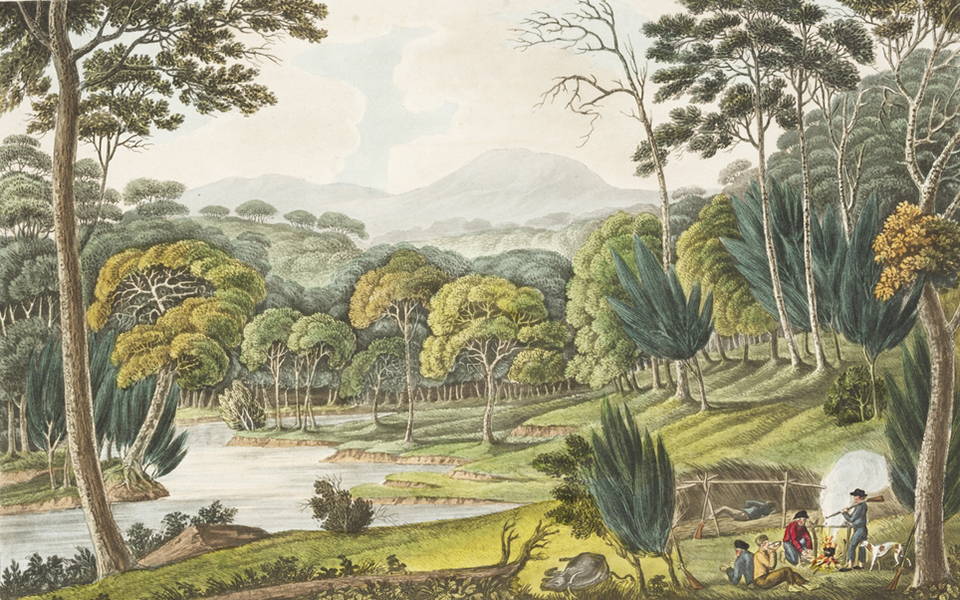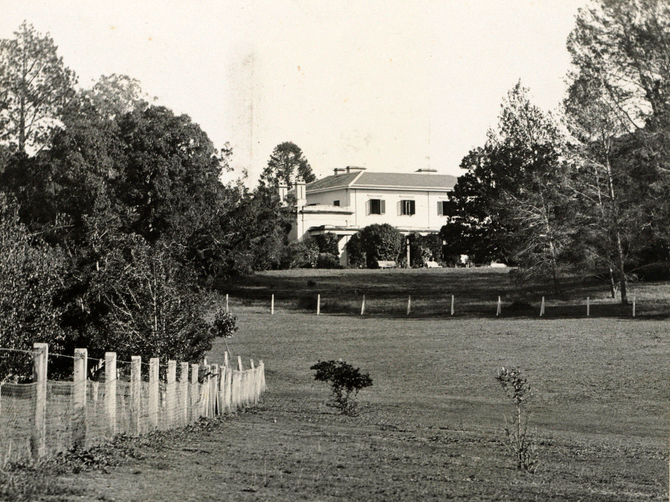The Dictionary of Sydney was archived in 2021.
Camden
Citation
Persistent URL for this entry
To cite this entry in text
To cite this entry in a Wikipedia footnote citation
To cite this entry as a Wikipedia External link
Camden
Camden is situated on the floodplain of the Nepean River, on the traditional land of the Dharawal people in an area known as the Cowpastures. The town is bordered in the east and north by the Nepean River, in the south by Burragorang Road and Camden Bypass and in the west by Matahil Creek. The town area had a population of 3,063 in 2001 and until the 1950s was the hub of a district which took in the rural villages to the west of Camden, including Yerranderie, Burragorang Valley, The Oaks and Oakdale, and to the north, Elderslie and Narellan. Today Camden is being engulfed by the rural–urban fringe of Sydney's metropolitan area.
Landscape
The Camden area's distinctive landscape has moulded the community's identity and sense of place. The central town area is enclosed on three sides by a sweeping bend in the Nepean River, which regularly floods the surrounding farmland and lower parts of the town. The floodplain creates a sense of openness around the town and symbolises the traditional values associated with country town life, which is still celebrated each year at the Camden Show. A ridge rises 25 metres from the flood plain to the south and is topped by St John's Anglican church, built shortly after the town was founded in 1840. St John's church is the basis of the town's iconic imagery and rural mythology and remains the symbolic heart of Camden.
Early European settlement
[media]From the earliest days of European settlement class and social networks ordered daily life in the village with the local gentry at the top of the social hierarchy. The interests of the landed gentry dominated the area from the time of John Macarthur's original grant of 5,000 acres (2,023 hectares) in 1805. Large landholders established a rural hegemony in the area based on five big estates built on convict labour: Camden Park, Brownlow Hill, Kirkham, Elderslie and Macquarie Grove.
[media]Many immigrant families came to the area under Governor Bourke's 1835 plan and settled on the gentry's estates as tenant farmers, some eventually establishing businesses in the new privately developed village of Camden. The first land sales in the village were held in 1841, which stifled the growth of the existing European settlements in the area at Cawdor (1822), Narellan (1827), Cobbitty (1828) and Elderslie (1828). The population of Camden grew from 242 in 1846 to 458 in 1856, although the village was still dominated by the estates of the gentry. Camden Park, for example, had a population of 900 in 1850.
The influence of the Macarthurs
[media]The gentry practised philanthropy in the new village to maintain its moral tone. The Macarthur family of Camden Park, who dominated Camden until the 1950s, granted land to each of the major denominations in the village for churches. The moral position of St John's, supported by the generosity of the Macarthur family, reinforced the influence of Elizabeth Macarthur Onslow from the 1880s and that of her daughter Sibella until her death in 1943. The social authority of these women was absolute. Nothing escaped their scrutiny or influence and St John's was central to their view of the world in Camden. Elizabeth Macarthur Onslow encouraged the maintenance of the proprieties of life, moral order and good works, as well as memorialising her family by donating a clock and bells to St John's Church in 1897. She also marked the memory of her late husband by providing a public park in 1882, named after her husband (Onslow Park), which is now the Camden showground.
[media]After Elizabeth reorganised the administration of Camden Park in the 1890s, she and Sibella ensured the prosperity of the estate and the village in the 'dairy revolution'. A series of technical and institutional innovations transformed the dairy industry and, combined with rail access to the Sydney market, assured the material progress of the town for the next 50 years. Progress was revealed in the construction of a new bank (1878), commencement of weekly stock sales (1883), the formation of the Camden Agricultural, Horticultural and Industrial Society and the first Camden Show (1886), a new post and telegraph office (1898), the foundation of two weekly newspapers ( Camden Times, 1879, Camden News , 1880), a new cottage hospital (1898), the formation of a fire brigade (1900), the opening of a telephone exchange (1910), the installation of reticulated gas (1912), electricity (1929), town water (1899) and the replacement of gas street lighting with electric lights (1932), and a sewerage scheme (1939). By 1933 the population of the town had grown to 2394.
Local government in Camden
[media]Local government in Camden dates back to 1843, when Camden , along with Campbelltown, Narellan and Picton, was one of 28 district councils in New South Wales formed to raise revenue for constructing roads, bridges and other infrastructure. Rivalries, localism and the opposition of the landed gentry all contributed to the council's eventual failure. In 1883, a public meeting was held to form the municipality of Camden. In 1887, 46 local signatories (townsmen) petitioned the New South Wales government, and the municipality was proclaimed in 1889, covering 7,000 acres (2,800 hectares) and including Camden and the village of Elderslie. The first council election was held in April of that year. Nine townsmen were elected as aldermen, and the first meeting was held at the School of Arts. Camden Municipal Council eventually became the Council of Camden in 1993. In 2007 Camden was the administrative centre of the Camden local government area which had a population of over 51,000 (2006) and an area of 201 square kilometres including Cobbitty, Narellan, Bringelly, Catherine Fields and Mount Annan. In 2007, the local government area was part of the state government's Sydney South West Growth Centre, planned to house 500,000 new residents.[media]
Camden town
[media]Camden's original grid pattern of streets is intact and contains a mix of commercial, educational, religious, residential and industrial uses, as it did in the 1840s. The Hume Highway carried through traffic along the main street (Argyle Street), with hundreds of daily coal truck movements, until the highway was rerouted to the Camden Bypass in 1976 with completion of the Macarthur Bridge across the Nepean River. Many Victorian and Art Deco shopfronts are still intact, and the height and setback of buildings in the main street has changed little in 70 years. The many laneways that characterised the main street have been filled with development and the car has replaced the horse and cart. Social networks were historically reinforced in this part of town by daily personal contact, along with Sale Day and the Camden Show when farmers came to town. The development of a cafe culture in recent years continues the social networking which remains one of Camden's principal 'country town' characteristics.
[media]The ridge on the southern side of the commercial precinct is topped by Menangle Road, which used to make its way out of town to Camden Park house, past the gatehouse (now located on the Old Hume Highway). Apart from St John's church (1840), the Menangle Road precinct has the rectory (1859) and a number of charming Federation and Californian bungalows, which were the homes of the Camden elite. The precinct is also the location of Macarthur Park (1905) which was dedicated to the townsfolk by Elizabeth Macarthur Onslow and contains the town's World War I memorial (donated by the Macarthur family). Macarthur Park is a fine example of an urban Victorian park and has a number of significant trees.
[media]The historic precinct of John Street runs north–south downhill to the floodplain from the commanding position of St John's church at the top of the ridge. Lower John Street is the location of the Italianate house Macaria (c1842), St Paul's Catholic church and the government buildings associated with the Camden police barracks (1878) and courthouse, (1857) and Camden Primary School. This area also contains the oldest surviving Georgian cottage in the town area, Bransby's Cottage (1842) in Mitchell Street. There is also the Camden Museum, which is part of the recently redeveloped Camden library and museum complex. These buildings are an excellent example of adaptive re-use of heritage buildings and at the same time illustrate the stages of the town's progress and development. The northern side of the complex was originally the Camden Temperance Hall (1867) and served as Camden Fire Station (1916–1993). The southern side of the complex was the School of Arts (1866), which served as the Camden Town Hall, while the rear of the building was occupied by Camden Municipal Council until it built a new office complex behind Macaria on the opposite side of John Street. The library was located in Macaria from 1967 until 1982, when it moved into the current building.
Transport
Camden was the transport hub of the district from the 1820s when the road network was largely set by the pattern of land grants. The earliest villages in the district predated Camden and then looked to Camden for cultural and economic leadership as the district's major centre. The arrival of the Camden tramway in 1882 meant that silver ore from Yerranderie (1871), and later coal, was shipped through the Camden railhead to Campbelltown, although from the late 1930s more coal was moved by road than rail. The locomotive, affectionately known as 'Pansy', travelled on the branch-line from Campbelltown, and in the 1940s had 24 weekday goods and passenger services.
Camden railway station and goods yard, now a car yard, were located on the floodplain on the north-eastern corner of the village. The train whistle marked the arrival of Sydney's newspapers and other goods and could be heard all over town.
In 1920 the Macarthur family set up the Camden Vale Milk Company and built a milk processing plant at the eastern end of the main street adjacent to the rail line. Whole milk was railed to Darling Harbour and bottled under its own label until 1926. Between 1920 and 1922 Camden Vale Milk, which became a cooperative in 1921, had 162 milk suppliers and 289 cream suppliers. Milk was delivered to the factory daily by horse and cart up until the 1940s.
'Best of British'
As an outpost of the British Empire, the community supported the notion that the 'Best of British' was the rule of daily life. There was strong support for British militarism in the Boer War and World War I, and for the defence of Australia in World War II, with men and women from many local families seeing action. Local branches of national patriotic funds and civil defence organisations were founded. World War II was brought close to home with a number of defence establishments in and around town, including Camden Airfield at Kirkham, Narellan Military Camp at Oran Park and the Eastern Command Training School at Studley Park. This enthusiasm for militarism was not repeated in later conflicts (such as the Korean War and Vietnam War) when the influence of the British Empire had largely disappeared in Camden as in the rest of the country.
Community organisations
Community organisations have been part of Camden life from the foundation of the town in the 1840s. In the late 1800s they were male-dominated, usually led by the landed gentry, and held informal political power through patronage. James Macarthur sponsored the Camden School of Arts (1865) and Agricultural, Horticultural & Industrial Society (later the Camden Show Society), while various lodges and the temperance movement were sponsored by the non-conformists.
A number of conservative women's organisations were established after Federation, led by a small clique of well-off local women. Their social position supported their husbands' political activities and the influence of the Macarthur family was felt in these organisations, such as the Camden Red Cross and Country Women's Association.
In the postwar era, the growth of the town, increasing levels of education, and economic prosperity provided by coal broke down many of the old hierarchies and challenged the existing political power structures. New community organisations like Rotary, and later the Chamber of Commerce, fostered business networks in the town. Ownership of the town's pioneering past was taken up by the Camden Historical Society, and later, the Camden Residents' Action Group saw the threat of urbanisation to the town's cultural identity. These organisations became new power brokers in the town. In 2008 the Camden local government area had over 250 voluntary organisations helping create the social capital that encourages community participation.
Sydney's influence
Camden has had an ambivalent relationship with Sydney. The town clearly benefited from its proximity to Sydney markets and services. On the other hand, townspeople resented interference in local affairs from 'outsiders', who were numerous (as in most country towns) in the form of the local policemen, teachers, public servants and doctors, despite the many benefits they brought to the town. Sydney-based decisions, like the flooding of the Burragorang Valley in the 1950s after the construction of Warragamba Dam and the closure of the tramway in 1963, reinforced these sentiments.
Sydney-based decisions continued to shape the town. In the 1970s, the town was targeted by the state government as a growth area under the Macarthur Growth Centre Plan (1973). Increasing levels of urbanisation have continued and threaten the loss of rural landscapes around the town. This has aroused a desire for a type of 'rural arcadia' by some in the community based on the iconic imagery of the picturesque country town, with the church on the hill, surrounded by rural vistas.
In response 'locals' have retreated to a nostalgic version of reality by creating a 'country town idyll' which is celebrated at the Camden Show, adopted by local government, businesses and community organisations, and used variously as a political weapon, a marketing tool and a tourist promotion. For many years one of the staunchest defenders of Camden's rural nature was an 'outsider', Dr Elizabeth Kernohan, veterinary surgeon, Camden mayor and member for Camden in the New South Wales Legislative Assembly, who died in 2004.
References
Alan Atkinson, Camden, Farm and Village Life in Early New South Wales, Oxford University Press, Melbourne, 1988
Camden Historical Society website, http://www.camdenhistory.org.au, accessed 12 May 2009











